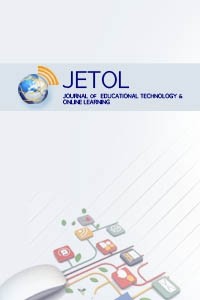Evaluation of prospective teachers’ digital literacy levels and mobile learning attitudes
Evaluation of prospective teachers’ digital literacy levels and mobile learning attitudes
___
- Anderson, J., Franklin, T., Yinger, N., Sun, Y., & Geist, E. (2013). Going mobile: Lessons learned from introducing tablet PCs into the business classroom. The Clute Institute International Academic Conference. Las Vegas: ABD.
- Botturi, L. (2019). Digital and media literacy in pre-service teacher education. Nordic Journal of Digital Literacy, 14(03-04), 147-163.
- Campbell, E. (2016). Pre-service teachers’ perceptions and practices: integrating digital literacy into English education (Unpublished Doctoral dissertation). University of Cape Town, South Africa.
- Churchill, N., Ping, L.Ç., Oakley, G., & Churchill, D. (2008). Digital storytelling and digital literacy learning. International Conference on Information Communication Technologies in Education, Readings in Education and Technology: Proceedings of ICICTE. Island.
- Clark, R. C., & Mayer, R. E. (2008). E-learning and the science of instruction: Proven guidelines for consumers and designers of multimedia learning. USA: Wiley
- Çam, E., Uysal, M., Kıyıcı, M., & İşbulan, O. (2019). Turkish culture adaptation of mobile learning attitude scale. International Journal of Turkish Educational Studies, 7(13), 114-125.
- Eshet-Alkalai, Y. (2004). Digital literacy: A conceptual framework for survival skills in the digital era. Journal of Educational Multimedia and Hypermedia, 13(1), 93-106.
- Fraenkel, J. R., Wallen, N. E., & Hyun, H. H. (2012). How to design and evaluate research in education. New York: McGraw-Hill.
- Furio, D., Juan, M. C., Seguí, I., & Vivo, R. (2015). Mobile learning vs. Traditional classroom lessons: a comparative study. Journal of Computer Assisted Learning, 31(3), 189-201.
- Gilster, P. (1997). Digital literacy. New York: John Wiley.
- Grix, J. (2010). The foundations of research. London: Palgrave Macmillan.
- Hair, J. F., Anderson, R. E., Tatham, R. L., & Black, W. (1998). Multivariate data analysis. Prentice Hall, Upper Saddle River: NJ.
- Hamutoğlu, N. B., Güngören, Ö. C., Uyanık, G. K., & Erdoğan, D. G. (2017). Adapting digital literacy scale into Turkish. Ege Journal of Education, 18(1), 408-429.
- Karakuş, G., & Ocak, G. (2019). An investigation of digital literacy self-efficacy skills of pre-service teachers in terms of different variables. Afyon Kocatepe University Journal of Social Sciences 21(1), 129-147.
- Khalid, S., Slaettalío, T., Parveen, M., & Hossain, M.S. (2015). A systematic review and metaanalysis of teachers’ development of digital literacy. Learning International Conference on Innovations in Digital Learning for Inclusion. Aalborg University, Denmark.
- Klopfer, E., & Squire, K. (2008). Environmental Detectives-the development of an augmented reality platform for environmental simulations. Educational Technology Research and Development, 56(2), 203-228.
- Knezek, G. & Khaddage, F. (2012). Bridging formal and informal learning: A mobile learning attitude scale for higher education. British Journal of Social Sciences, 1(2), 101-116.
- Lin, H. H., Lin, S., Yeh, C. H., & Wang, Y. S. (2016). Measuring mobile learning readiness: scale development and validation. Internet Research, 26(1), 265-287.
- Manovich, L. (2001). The language of new media. MIT Press: Cambridge, Mass.
- Martin, A. (2008). Digital literacy and the “digital society”. Digital literacies: Concepts, Policies and Practices, 30(2008), 151-176.
- Martin, F., & Ertzberger, J. (2013). Here and now mobile learning: An experimental study on the use of mobile technology. Computers & Education, 68, 76-85.
- Ng, W. (2012). Can we teach digital natives digital literacy? Computers & Education, 59(3), 1065-1078.
- Olsson, L., & Edman-Stålbrant, E. (2008). Digital literacy as a challenge for Teacher Education. In IFIP World Computer Congress. Boston, MA: Springer.
- Öztürk, Y., & Budak, Y. (2019). Research on preservice teachers’ own perception of digital literacy. The Journal of Kesit Academy 5 (21), 156-172.
- Seppala, P., & Alamaki, H. (2003). Mobile Learning in teacher training. Journal of Computer Assisted Learning, 19, 330-335.
- PWC (2018). The 2018 Digital University. Retrieved from https://goo.gl/znyzi1
- Rizal, R., Setiawan, W., & Rusdiana, D. (2019, February). Digital literacy of preservice science teacher. Journal of Physics: Conference Series. IOP Publishing.
- Sandkuhl, K., & Lehmann, H. (2017). Digital transformation in higher education–The role of enterprise architectures and portals. Digital Enterprise Computing.
- Sarıkaya, B. (2019). Evaluation of digital literacy status of prospective Turkish teachers in terms of various variables Journal of International Social Research, 12(62), 1098-1100.
- Trifonova, A. (2003). Mobile learning: Review of the literature. Technical Report, Department of Informatıon and Communication Technology, University of Trento.
- Yazıcıoğlu, A., Yaylak, E., & Genç, G. (2020). Digital literacy levels of prospective preschool and primary school teachers. The Journal of Social Sciences Research, 10(2), 274-286.
- Yeap, J. A., Ramayah, T., & Soto-Acosta, P. (2016). Factors propelling the adoption of m-learning among students in higher education. Electronic Markets, 26(4), 323-338.
- Yontar, A. (2019). Digital literacy levels of teacher candidates. Journal of Mother Tongue Education, 7(4), 815-824.
- ISSN: 2618-6586
- Yayın Aralığı: Yılda 3 Sayı
- Başlangıç: 2017
- Yayıncı: Gürhan DURAK
Elif Buğra KUZU DEMİR, Ahmet Bilal ÖZBEK, Kadir DEMİR
Language teachers’ perceptions of using Google keyboard in L2 writing
Okay DEMİR, Seda AKTI ASLAN, Mustafa DEMİR
Evaluation of prospective teachers’ digital literacy levels and mobile learning attitudes
Technology-based professional development program: Experiences of science teachers
Şule ELMALI, Fatime BALKAN KIYICI
Do vocational college students ready for online learning in post-COVID instruction?
Harun CİGDEM, Umut Birkan ÖZKAN
Distance education in nursing: Readiness and satisfaction levels of students
